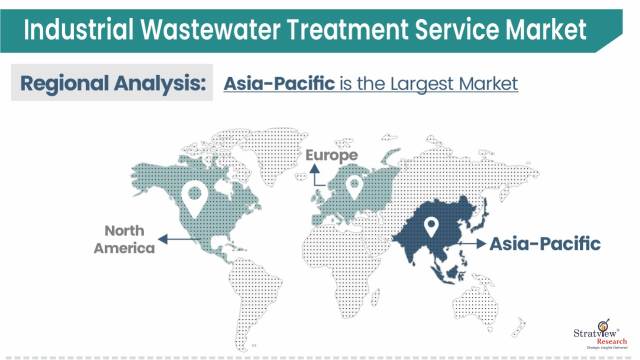Segment Analysis
|
Segmentations
|
List of Sub-Segments
|
Segments with High-Growth Opportunity
|
|
Service-Type Analysis
|
Design-Build-Operate, Operate Only, Emergency Response, and Sludge Management
|
Design-Build-Operate is expected to remain dominant in the coming years.
|
|
Technology-Type Analysis
|
Membrane Bioreactor, Activated Sludge Process, Trickling Filter, and Biological Nutrient Removal
|
Membrane Bioreactor holds the largest share of the market in the upcoming years.
|
|
Industry-Type Analysis
|
Oil & Gas, Chemicals, Food & Beverage, Textiles, and Automotive
|
Chemicals are expected to remain dominant throughout the forecast period.
|
|
Treatment Capacity-Type Analysis
|
Up to 100,000 GPD, 100,000–1,000,000 GPD, 1,000,000–5,000,000 GPD, and Over 5,000,000 GPD
|
1,000,000–5,000,000 GPD is projected to be the leading segment in the market.
|
|
Region Analysis
|
North America, Europe, Asia-Pacific, and The Rest of the World
|
The Asia-Pacific is expected to maintain its reign over the forecast period.
|
By Service Type
“Design-Build-Operate services are expected to remain the dominant service type of the industrial wastewater treatment service market during the forecast period.”
It is expected that operation & process control services will lead the market since they are key to making sure wastewater treatment plants are efficient and compliant. They regularly watch the system’s performance, reduce the use of chemicals, and make sure the discharge standards are met all the time. As companies focus on being efficient and environmentally friendly, they are relying more on expert services for controlling their processes.
In addition, the growing strictness of environmental rules in both developed and developing countries leads industries to use advanced control systems to avoid being penalized and damaging their reputation. The category is also being helped by using automation and IoT in water treatment, which means there is a need for constant monitoring and careful management
By Technology Type
“Membrane Bioreactor (MBR) technology is expected to lead the market due to its high efficiency and advanced treatment capabilities.”
The high efficiency, small size, and capacity for treating high-load wastewater make MBR technology the leader in this category. It combines membrane filtration with biological treatment, resulting in effluent that meets the strictest regulations. MBR is becoming more popular in food & beverage and pharmaceutical industries, where the rules for wastewater discharge are very strict, and using water more than once is key.
As the cost of membrane technology drops and automation becomes easier, more MBR systems are being put into use. Because there is not enough water in places like the Middle East and Asia, there is a greater need for water reuse and recycling, which helps MBR systems to be more popular in industrial wastewater treatment.
By Industry Type
“The chemicals industry is expected to remain the dominant user of industrial wastewater treatment services, while the food & beverage industry is projected to grow at a notable pace.”
Due to the many different and potentially dangerous chemicals used in the industry, chemical companies are the biggest customers of wastewater treatment services. Since there are strict rules in the industry and the treatments often use multiple stages, only experienced companies and advanced technology are needed.
Besides, chemical manufacturers are being urged to use ZLD systems, which leads to a higher demand for specialized and capable treatment services. As more money is invested in chemical manufacturing in Asia-Pacific and the Middle East, the segment is set to continue leading the industry over the next few years.
By Treatment Capacity Type
“The 1,000,000–5,000,000 GPD capacity range is anticipated to continue dominating the market during the forecast period.”
Because medium to large industrial facilities need this amount of water, the 1,000,000–5,000,000 GPD segment is expected to lead the market. This type of treatment is used in many industrial plants, so it is the most common. They manage to be efficient and scalable, so they work well without needing the huge infrastructure of systems that process more than 5,000,000 gallons per day.
Besides, the increasing number of industrial parks and multi-facility complexes globally, especially in Asia and Latin America, means that centralized wastewater treatment plants with this capacity are needed. Such systems are able to process changing loads and still meet the strict requirements for discharging effluents
Regional Insights
“Asia-Pacific is expected to maintain its dominance in the industrial wastewater treatment service market throughout the forecast period.”
The Asia-Pacific region is expected to lead the industrial wastewater treatment service market over the forecast period because of its fast industrial and urban growth, and growing concern for the environment. China and India are spending a lot on water infrastructure and regulation, which has resulted in a rise in the need for wastewater treatment services in many fields.
In addition, the existence of big chemical, textile, and manufacturing centers in China, South Korea, and Vietnam also helps increase demand. The government’s actions to cut industrial pollution and encourage water reuse are supporting the demand for long-term water treatment contracts in areas facing water shortages and tough regulations.

Know the high-growth countries in this report. Register Here

